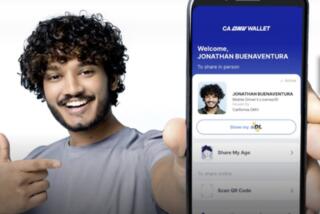CITY SMART: How to thrive in the urban environment of Southern California. : State License Plates Offer PL8TALC or 4WHLVRS or 139,932,000 Other Possibilities
In this age when floor mats cost $80 and even a broken hood ornament can set you back $30, there are still a few values on the open road. In fact, the one piece of equipment that will probably outlast your car runs a mere $1.58: the license plate.
Manufactured by felons making 55 cents an hour up at Folsom State Prison, the pressed aluminum plates adorning the 27 million or so vehicles in California are an even better value when you consider that they do so much more than simply keep us straight in some computer.
For instance, poets and artists have strung them together to create verse. In his book “PL8SPK,” Silver Lake author Daniel Nussbaum combed through some of the million or so personalized plates in California to put a new spin on the classics.
To Nussbaum, the opening of Genesis translates to INTHE BEGINNG DYD GODCR8 HEAVEN PLUS EARTH. Hamlet is reduced to 2BORWAT? And Vladimir Nabokov’s tale of forbidden love becomes LOLITA: ID8JLB8T. SOAMI AA PERV?
Less inventive motorists use the 12-inch by 6-inch space to advertise their own vanities and insecurities in clipped slogans of seven letters or less. Consider the contractor who proclaims himself BIGMAN7. Or the sports chiropractor who is ATHDOC to those behind him. Or the free spirit whose variation on carpe diem reads CZDMMNT.
So ubiquitous and universal are personalized plates that the NBC television comedy “Seinfeld” even built an entire episode around Kramer inadvertently receiving plates intended for a proctologist. While maybe that could happen in laid-back New York, California officials--who censor plates they consider offensive--would never allow ASSMAN to grace the back end of a car here.
Even if ASSMAN is a bust, there are literally billions of other combinations for plates in California. For those who like such things, the exact number of possible letter and number combinations is 94,931,877,133--or roughly enough to license about 17 vehicles for each and every one of the 5.5 billion or so human beings on Earth.
That assumes all seven spaces on current plates can be any mix of 26 letters and 10 numerals, plus empty slots. Under Department of Motor Vehicle rules, though, there are only about 139,932,000 possibilities--not including personalized plates.
The reason: California has a very specific way of numbering its everyday plates. The first of the seven spaces on passenger cars is always a number. It began with 1 back in 1971 and is now up to 3. The next three places are letters, now up to M, and the final three are numbers. The third letterspace can never be an O, Q or I because they may be confused with adjacent numbers.
Confused? Then it’s probably best not to consider commercial vehicles, which have a different system altogether. And no combinations are reused. Once a car dies, its license number dies--unless it is a personalized plate, which stays with the owner. Rest assured, though, there is little risk of running out of numbers in the foreseeable future.
“It won’t happen in our lifetime,” said Maria Barajas, the DMV special license plate manager in Sacramento. Barajas oversees administration of the six special interest license plates. These have designs such as views of Yosemite, and the extra fee they carry goes to the organization sponsoring the plates.
*
The UCLA plate helps fund scholarships, and the Yosemite plate pays for special projects in the national park. In addition to those six, there is a range of “recognition plates,” denoting everything from press photographers and ex-prisoners of war to ham radio operators.
For most, though, the standard issue plate of reflective white with blue characters suffices.
Plates now are made of aluminum, but way back in the early days of automobiles, they were put together with whatever folks had handy. The state did not get into the business of making license plates until 1914--although it has required them since 1905.
For the first nine years, the state issued numbers to cars and guidelines to their owners to make their own. The plates were required to be white with numerals in black three inches high and half an inch wide, and “State of California” written somewhere in inch-high black letters.
Aside from that, motorists were on their own. So plates came in all types--from ornate porcelain with inlaid brass numbers to plain old flat pieces of painted metal. Some were even made of wood or leather.
Cars from this era can still use these antique plates, provided they carry a special sticker from the DMV. The stickers we now use to renew our plates every year have only been in use since 1955. Before that, the state sent out brand-new plates every year.
And although it is the world’s biggest cliche, license plates are indeed made by convicts. Since 1947, inmates at Folsom have been pressing plates. The average output of the 100 inmates assigned to plate duty is now 35,000 to 40,000 per day.
And though the shop has worked smoothly for almost half a century, production manager Larry Campoy said the prison has no plans to expand into other markets. “We’re the only license plate manufacturer in California,” he said, explaining that the state is the prison’s only client.
“We have kind of a captive market,” he noted dryly.
More to Read
Sign up for Essential California
The most important California stories and recommendations in your inbox every morning.
You may occasionally receive promotional content from the Los Angeles Times.









